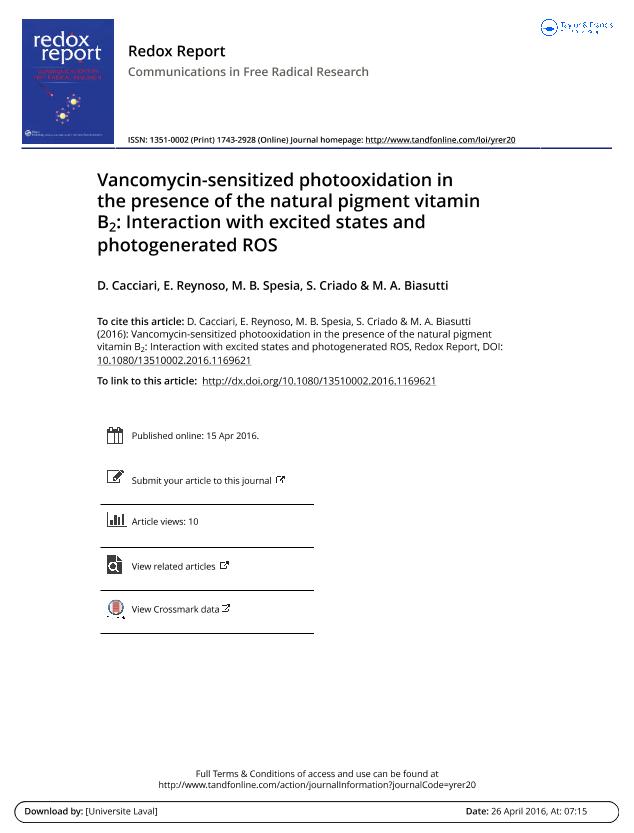Mostrar el registro sencillo del ítem
dc.contributor.author
Cacciari, Rodolfo Daniel

dc.contributor.author
Reynoso, Eugenia

dc.contributor.author
Spesia, Mariana Belen

dc.contributor.author
Criado, Susana Noemi

dc.contributor.author
Biasutti, Maria Alicia

dc.date.available
2022-12-01T13:36:50Z
dc.date.issued
2016-04
dc.identifier.citation
Cacciari, Rodolfo Daniel; Reynoso, Eugenia; Spesia, Mariana Belen; Criado, Susana Noemi; Biasutti, Maria Alicia; Vancomycin-sensitized photooxidation in the presence of the natural pigment vitamin B2: Interaction with excited states and photogenerated ROS; Maney Publishing; Redox Report; 22; 4; 4-2016; 166-175
dc.identifier.issn
1351-0002
dc.identifier.uri
http://hdl.handle.net/11336/179771
dc.description.abstract
Sensitized photooxidation processes in the presence of natural pigments may provide an alternative to antibiotics degradation since these compounds are transparent to natural light irradiation, therefore, they can be degraded by the action of photosensitizers which absorb light and produce highly reactive species, especially those derived from molecular oxygen (ROS). Most antibiotics used currently belong to a group of pharmaceutical substances that have been considered a new type of contaminants due to their persistence and bioaccumulation in the environment. Objective: In this context, we decided to investigate the kinetic and mechanistic aspects of Vancomycin (Vanco) photosensitized degradation in the presence of the natural pigment Riboflavin (Vitamin B2, Rf) and the artificial dye Rose Bengal (RB) for comparative purposes. Methods: The study have been done by using Stationary photolysis, Laser flash photolysis, Time-resolved phosphorence detection of O2(1Δg) experiments and Bactericidal activity evaluation. The experiments were carried out in aqueous solution at different pH values in order to establish relationships between the structure of the compound and its susceptibility to ROS-mediated photooxidation. Results: Experimental evidence indicates that in the presence of Rf there is considerable contribution of the radical-mediated mechanism, while in the presence of RB the photooxidation process occurs exclusively through O2(1Δg) and the reactivity to this excited species increases with increasing pH of the environment. Discussion: The results obtained, have been shown that Rf can raise the photodegradation of Vanco by both the radical pathway and the O2(1Δg) mediated. Furthermore, the antibiotic is able to interact with the excited electronic states of Rf as well as O2(1Δg) generated by energy transfer between the excited triplet state of the photosensitizer and the oxygen ground state. The predominant mechanism for photodegradation of Vanco in the presence of the Rf is the radical via because of the considerable interaction with the excited triplet state of the photosensitizer demonstrated by laser flash photolysis experiments. Microbiological test on Staphylococcus aureus ATCC25923 showed that the bactericidal activity of the antibiotic on the strain studied was affected by the sensitized photodegradation process, suggesting that photoproducts generated eventually do not retain the bactericidal properties of the original antibiotic.
dc.format
application/pdf
dc.language.iso
eng
dc.publisher
Maney Publishing

dc.rights
info:eu-repo/semantics/openAccess
dc.rights.uri
https://creativecommons.org/licenses/by-nc-sa/2.5/ar/
dc.subject
ANTIBIOTICS
dc.subject
MICROBIOLOGICAL ASSAY
dc.subject
PH EFFECT
dc.subject
PHOTOOXIDATION
dc.subject
REACTIVE OXYGEN SPECIES
dc.subject
RIBOFLAVIN
dc.subject
ROSE BENGAL
dc.subject
VANCOMYCIN
dc.subject.classification
Físico-Química, Ciencia de los Polímeros, Electroquímica

dc.subject.classification
Ciencias Químicas

dc.subject.classification
CIENCIAS NATURALES Y EXACTAS

dc.title
Vancomycin-sensitized photooxidation in the presence of the natural pigment vitamin B2: Interaction with excited states and photogenerated ROS
dc.type
info:eu-repo/semantics/article
dc.type
info:ar-repo/semantics/artículo
dc.type
info:eu-repo/semantics/publishedVersion
dc.date.updated
2022-11-30T22:33:37Z
dc.journal.volume
22
dc.journal.number
4
dc.journal.pagination
166-175
dc.journal.pais
Reino Unido

dc.journal.ciudad
London
dc.description.fil
Fil: Cacciari, Rodolfo Daniel. Universidad Nacional de Río Cuarto. Facultad de Ciencias Exactas Fisicoquímicas y Naturales. Departamento de Química; Argentina. Consejo Nacional de Investigaciones Científicas y Técnicas. Centro Científico Tecnológico Conicet - Córdoba; Argentina
dc.description.fil
Fil: Reynoso, Eugenia. Universidad Nacional de Río Cuarto. Facultad de Ciencias Exactas Fisicoquímicas y Naturales. Departamento de Química; Argentina. Consejo Nacional de Investigaciones Científicas y Técnicas. Centro Científico Tecnológico Conicet - Córdoba; Argentina
dc.description.fil
Fil: Spesia, Mariana Belen. Universidad Nacional de Río Cuarto. Facultad de Ciencias Exactas Fisicoquímicas y Naturales. Departamento de Química; Argentina. Consejo Nacional de Investigaciones Científicas y Técnicas. Centro Científico Tecnológico Conicet - Córdoba; Argentina
dc.description.fil
Fil: Criado, Susana Noemi. Consejo Nacional de Investigaciones Científicas y Técnicas. Centro Científico Tecnológico Conicet - Córdoba; Argentina. Universidad Nacional de Río Cuarto. Facultad de Ciencias Exactas Fisicoquímicas y Naturales. Departamento de Química; Argentina
dc.description.fil
Fil: Biasutti, Maria Alicia. Universidad Nacional de Río Cuarto. Facultad de Ciencias Exactas Fisicoquímicas y Naturales. Departamento de Química; Argentina. Consejo Nacional de Investigaciones Científicas y Técnicas. Centro Científico Tecnológico Conicet - Córdoba; Argentina
dc.journal.title
Redox Report

dc.relation.alternativeid
info:eu-repo/semantics/altIdentifier/doi/http://dx.doi.org/10.1080/13510002.2016.1169621
dc.relation.alternativeid
info:eu-repo/semantics/altIdentifier/url/https://www.tandfonline.com/doi/full/10.1080/13510002.2016.1169621
Archivos asociados
